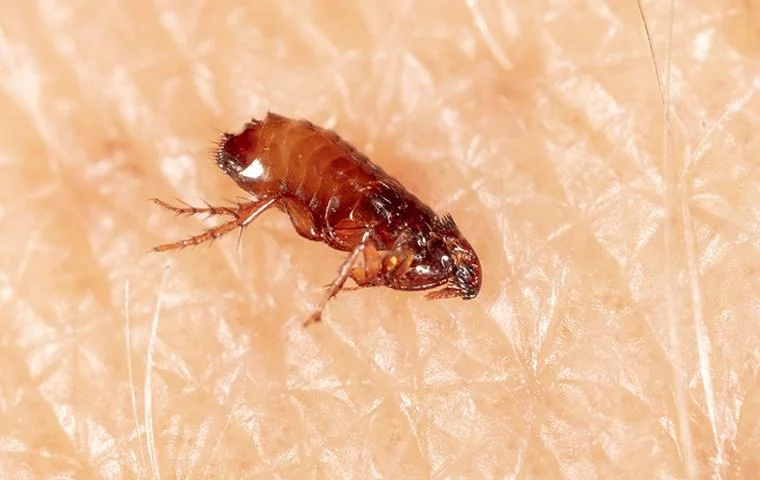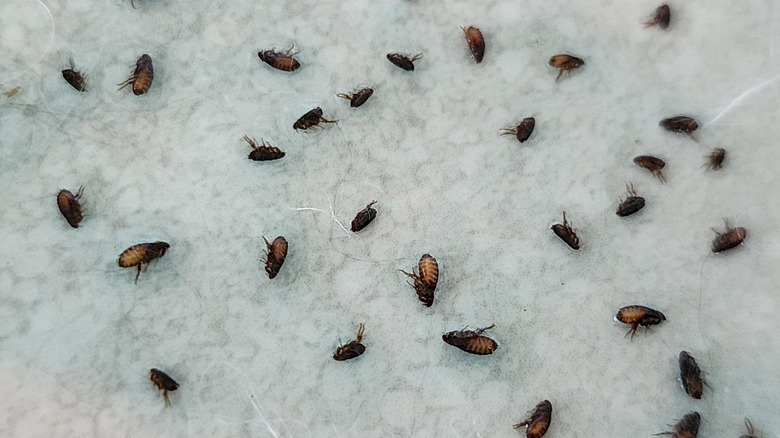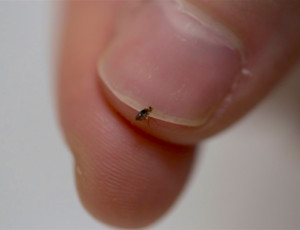Florida’s appealing subtropical climate, recognized for its gentle winters and high humidity, provides near-perfect conditions for many pests, among them fleas. These tiny insects target warm-blooded hosts—most often household pets but sometimes humans—multiplying rapidly if not addressed. In an upscale locale like Coral Gables, failing to contain fleas promptly can spark ongoing occupant frustration, itchy bites, and possible disease concerns. This service page clarifies how fleas thrive in Florida’s environment, the signals hinting at a potential infestation, and why a professional flea exterminator for comprehensive flea treatments remains the most thorough solution. Acting quickly at the earliest sign of fleas saves families, pets, or property managers from spiraling infestations that compromise daily comfort and occupant morale.
Why Fleas Prosper in Florida

- Mild Winters and Year-Round Warmth
In many states, sub-freezing winters cut back flea populations or push them into dormancy. Florida rarely endures such extended cold, letting fleas remain consistently active. Even short dips in temperature don’t last, and within air-conditioned or heated interiors, fleas face no seasonal pause to reproduction. This climate-friendly environment means a small introduction can become a robust colony if occupant vigilance fails. - High Humidity and Rain
Flea eggs and larvae need moisture, as they desiccate easily in dry conditions. Florida’s typical high humidity and regular rainfall keep soils and yard corners damp, fostering larval development. Shaded or lightly watered lawn patches, combined with occasional standing water, offer fleas a haven until they hitch rides on passing pets or wildlife. - Minimal Seasonal Downtime
In colder regions, fleas experience natural setbacks or die-offs during harsh winters. Southwest Florida’s mild winter means fleas rarely face lethal cold. They remain capable of biting and reproducing practically year-round, meaning occupant routines must remain consistent—like vacuuming or yard checks—to prevent persistent infestations. - Frequent Pet Movement
From dogs exploring neighborhood parks to cats roaming private yards, Florida’s pets frequently encounter fleas outdoors. If unprotected by monthly flea preventatives, they bring adult fleas inside. Also, wildlife like raccoons or possums traveling near properties can deposit fleas, which then await household pets as hosts. - Human Mobility
Coral Gables receives visitors, short-term renters, and new residents. Fleas can move undetected in clothing, luggage, or secondhand furniture. If occupant checks (like vacuuming or washing items) are lax, fleas quietly settle on carpets, pet bedding, or hidden corners, building up unless occupant sightings trigger action.
Indicators of a Flea Infestation
- Pet Scratching or Grooming Excessively
Fleas cause incessant itching for dogs or cats, leading them to bite or scratch their fur persistently. Areas around the neck, belly, or hindquarters are common flea feeding sites. Pets showing hair loss or red patches from intense scratching might have fleas. Using a fine-toothed comb reveals small, dark fleas or black “flea dirt” that turns red when moistened. - Bites on Humans
Though fleas favor animals, they bite people if pet hosts are unavailable. Flea bites commonly appear as small, red welts around ankles or lower legs, arranged in lines or clusters. If occupant bites recur—despite minimal exposure to mosquitoes—fleas may be active in carpets or furniture. - Flea Dirt in Pet Areas
Flea feces, looking like coarse black pepper, can gather in pet bedding or corners of rooms. Sprinkling these specks onto a damp paper towel typically produces a reddish-brown smear, confirming digested blood. This is a telling sign fleas are present and feeding on your dog or cat. - Adult Fleas Hopping on Floors
Adult fleas often jump when disturbed, making them noticeable if occupant footsteps or vacuuming stirs them from carpets or rugs. Spotting tiny, dark-brown insects leaping near your feet or around pet crates suggests a significant population already established. - Reduced Pet Comfort in Familiar Spots
A pet might avoid a once-preferred resting area if fleas saturate that bedding or corner. Investigating those spots may uncover fleas or eggs waiting for a warm-blooded host. Addressing such zones quickly with cleaning and professional treatments halts their expansion.
Why Swift Flea Treatments Are Needed
- Potential Disease Concerns
While not as notorious as some pests, fleas can carry parasites such as tapeworms that infect animals or, in rare cases, humans. Large-scale infestations on a small pet may cause anemia from blood loss, endangering animals. Prompt eradication lowers these health threats significantly. - Excessive Itching and Pet Distress
Ongoing flea bites cause relentless scratching, biting, and potential allergic reactions (flea allergy dermatitis) in pets. Some animals develop raw skin or secondary infections. Occupant or veterinarian interventions, plus thorough property treatment, alleviates these complications. - Spread to Neighbors
In multi-unit housing or closely spaced neighborhoods, fleas may jump from shared yard edges if occupant diligence or coordinated extermination is lacking. Early occupant action blocks fleas from wandering across property lines or into adjacent units. - Daily Occupant Frustration
Constantly vacuuming, washing linens, or discovering fresh bites hamper occupant comfort. Thorough extermination lifts this burden, letting residents and pets move around rooms and yards without constant dread of hidden fleas.

Why a Professional Exterminator Is Most Effective
- Complete Indoor-Outdoor Assessment
A flea exterminator reviews the entire property—carpets, furniture seams, pet bedding, yard edges—pinpointing flea hotspots. Identifying species (often the cat flea) and exact distribution clarifies whether the issue is largely indoors, outdoors, or both. With this map, they deploy targeted solutions at each stage. - Safe, Targeted Use of Chemicals
Excessive DIY sprays can endanger occupant health or beneficial organisms while failing to reach concealed eggs. Professionals strategically apply insecticides or insect growth regulators in yard corners, baseboard crevices, or around pet rest zones. This measured approach kills fleas while preserving occupant or pet safety. - Multi-Stage Life Cycle Disruption
Fleas develop through egg, larva, pupa, and adult stages. Missing pupae or eggs allows fleas to reappear after adult fleas die. Professionals integrate insect growth regulators, larvicides, and occupant-based vacuuming to kill fleas across every stage, ensuring no wave resurges. - Pet Collaboration
Environmental treatments alone fail if occupant animals remain unprotected, carrying fleas from yard to indoors. Exterminators underscore occupant synergy with veterinarian-prescribed flea preventatives—like spot-ons or oral meds—killing fleas feeding on pets and breaking the cycle. - Follow-Up Confirmation
Because eggs might hatch weeks after initial service, occupant vigilance or scheduled re-checks confirm no new fleas slip through. If occupant bites reoccur or fresh adult fleas appear, further spot treatments finalize eradication for occupant relief.
Methods a Flea Exterminator Might Use
- Vacuuming and Steam
A thorough vacuum session across carpets, rugs, and pet bedding collects adult fleas, eggs, and larvae. Exterminators or occupants discard vacuum contents sealed in plastic outside. Steam cleaning can destroy fleas deeper in fibers or furniture where insecticides might not penetrate fully. - Insect Growth Regulators (IGRs)
Spraying or fogging with IGRs inside prevents larvae from maturing into biting adults. Outdoors, larvicides along shady corners or fence lines hamper eggs. Occupants must wait until the product dries and adhere to recommended re-entry intervals. - Residual Sprays
Spraying adulticidal chemicals in yard edges, baseboards, or pet bedding zones kills fleas crossing treated surfaces. Many solutions remain active for days or weeks, targeting new hatchlings. Occupants typically keep children and pets clear until dryness. - Pet and Vet Care
Ensuring occupant animals remain on monthly flea preventatives from veterinarians stops fleas from feeding and reproducing. Regular comb checks, grooming, and washing pet bedding weekly hamper newly arrived fleas or stray eggs. - Follow-Up Checks
Because dormant pupae can lie undisturbed for weeks, occupant or professional re-checks confirm no second wave emerges. Sticky traps or occupant scanning for fresh bites ensures no overlooked fleas hatch. If occupant sightings persist, spot re-treatments finalize elimination.
Serving Coral Gables
Coral Gables—recognized for its historic Mediterranean Revival architecture and proximity to Miami—enjoys lush greenery and year-round mild temperatures. Pets roaming local yards or strolling through city parks may encounter fleas waiting in shady corners or among leaf litter. Residents who combine occupant diligence—like vacuuming carpets, sealing yard edges from wildlife, and washing pet blankets weekly—with timely professional assistance keep fleas from spoiling this city’s charm. Swift occupant reaction at the earliest sign of bites or dog scratching ensures fleas do not spread across multiple rooms, furniture, or even to neighboring properties.

Why Our Flea Treatments Excel
- Florida-Focused Tactics
Since southwestern Florida’s winter rarely eliminates fleas, we integrate occupant-based yard management (like clearing debris, mowing grass short) with insect growth regulators, adulticidal sprays, or steam cleaning for a broad approach. Addressing fleas from egg to adult suits year-round mild conditions. - Precision and Limited Chemical Exposure
Rather than spraying large areas blindly, we identify prime flea hideouts—pet bedding, baseboards, fence lines—and apply insecticides or IGRs precisely. Occupants wait for drying or airing out, ensuring minimal risk while fleas face lethal coverage. - Emphasis on Pet Health
We urge occupant collaboration with veterinarian advice on monthly flea preventatives. Medicated pets deny fleas the blood meal needed to reproduce, shutting down re-infestation cycles or fleas crossing from yards to carpets. - Re-Check Assurance
Because fleas can remain dormant in pupae for weeks, occupant or professional re-checks confirm no fresh wave emerges. If occupant sightings persist, we refine or intensify solutions promptly, ensuring occupant comfort returns swiftly.
Call to Action
Spotting your dog gnawing at fur nonstop, discovering specks of “flea dirt” on pet blankets, or suffering small red bites on ankles after stepping indoors? Contact us to learn more or schedule your service. Our flea exterminator measures in Coral Gables tackle fleas at each phase—egg, larva, pupa, adult—across indoor carpets and outside lawn corners. By acting quickly, you sidestep extended bites, potential disease risks, and occupant frustration these persistent parasites can unleash.
Maintaining a Flea-Free Environment
Once fleas are eradicated, consistent occupant habits keep them from resurfacing:
- Vacuum Regularly: Thoroughly vacuum carpets, rugs, or upholstered furniture, especially in pet areas. Dispose of vacuum contents sealed in plastic offsite.
- Wash Pet Bedding: Launder pet blankets, crate pads, or cat trees on hot settings weekly, finishing with a high-heat dryer cycle. Any leftover eggs or larvae perish in high heat.
- Use Pet Preventatives: Dogs and cats should remain on monthly flea preventatives—topicals, chewables, or collars, as recommended by a veterinarian. Fleas jumping on medicated animals die quickly.
- Yard Upkeep: Mow grass short, remove leaf piles, and minimize damp corners around fence lines. If stray animals frequent your yard, deny them reason to linger by securing trash or leftover pet food bowls.
- Post-Travel or Boarding Checks: If pets visit kennels or you bring secondhand furniture home, inspect for fleas before merging them into primary living spaces. Quick occupant detection averts potential re-infestation.
In southwestern Florida’s mild climate, fleas can flourish if occupant practices or timely professional help are lacking. However, occupant vigilance—like vacuuming or yard maintenance—combined with proven extermination solutions ensures fleas cannot take root anew. Freed from hidden pests jumping around corners or incessantly biting pets, property owners in Coral Gables can instead appreciate the city’s greenery, cultural flair, and year-round sunshine, confident that fleas have no easy foothold in their living or working spaces.
